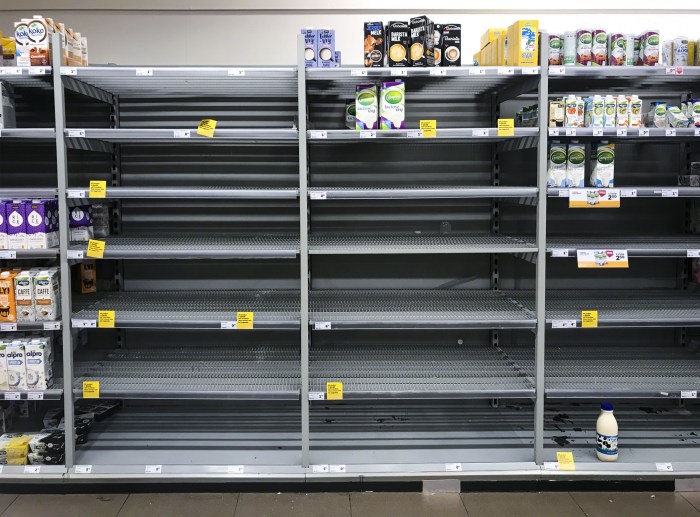This image of nearly empty shelves of bottled water indicates a growing problem of water scarcity and supply chain disruptions. As communities face the threat of water shortages, this image serves as a stark reminder of the urgent need for sustainable water management practices and government intervention.
The following discussion will delve into the reasons behind this shortage, its potential impact on communities and ecosystems, and the measures that can be taken to address this critical issue.
Water Scarcity and Shortages
The image of nearly empty shelves of bottled water is a stark reminder of the growing water scarcity and shortages faced by communities around the world. Water scarcity occurs when the demand for water exceeds the available supply, leading to competition and potential conflicts over water resources.
Water scarcity can have severe consequences for communities and ecosystems. It can lead to reduced agricultural productivity, food insecurity, and health problems. In extreme cases, water scarcity can even trigger migration and conflict.
Regions Facing Water Shortages
- California, USA
- São Paulo, Brazil
- Cape Town, South Africa
- Beijing, China
In these regions, water shortages have led to rationing, price increases, and even social unrest. Governments and communities are implementing various measures to address water scarcity, such as water conservation programs, desalination plants, and increased investment in water infrastructure.
Supply Chain Disruptions

The COVID-19 pandemic has disrupted global supply chains, including the bottled water industry. Transportation issues, production delays, and labor shortages have made it difficult for bottled water companies to meet demand.
In addition, panic buying and stockpiling have exacerbated the supply chain disruptions. When consumers fear a shortage, they often purchase large quantities of bottled water, which can lead to empty shelves and higher prices.
Case Studies of Supply Chain Disruptions
- In March 2020, a major bottled water company in the United States experienced a production delay due to a COVID-19 outbreak at one of its plants.
- In April 2020, a major transportation company suspended deliveries of bottled water to certain regions due to a shortage of truck drivers.
These disruptions have highlighted the vulnerability of the bottled water supply chain and the need for increased resilience.
Consumer Demand and Panic Buying
Consumer demand and panic buying play a significant role in exacerbating the shortage of bottled water. When consumers perceive a threat to their water supply, they often engage in panic buying, which can lead to hoarding and empty shelves.
Panic buying is driven by a variety of psychological and social factors, including fear of scarcity, herd mentality, and a desire to be prepared for an emergency.
Recommendations for Managing Consumer Demand, This image of nearly empty shelves of bottled water indicates
- Educate consumers about the importance of water conservation and the limited supply of bottled water.
- Encourage consumers to store water in reusable containers instead of purchasing bottled water.
- Implement policies to limit the purchase of bottled water during emergencies.
Environmental Concerns

The increased consumption of bottled water has significant environmental implications. Plastic bottles are a major source of plastic pollution, which can harm wildlife and pollute ecosystems.
The production and transportation of bottled water also require significant amounts of energy and water resources.
Alternative Solutions for Hydration
- Promote the use of reusable water bottles and tap water.
- Invest in public water fountains and water filtration systems.
- Explore innovative ways to reduce the environmental footprint of bottled water, such as using biodegradable or plant-based materials for bottles.
Government and Regulatory Responses: This Image Of Nearly Empty Shelves Of Bottled Water Indicates

Governments and regulatory agencies play a crucial role in addressing the bottled water shortage. They can implement measures to ensure access to safe drinking water, prevent price gouging, and protect the environment.
Some governments have declared states of emergency and implemented water rationing. Others have increased production of bottled water and provided financial assistance to affected communities.
Examples of Government Interventions
- In California, the government has implemented a mandatory water conservation program and provided funding for water infrastructure projects.
- In Brazil, the government has launched a campaign to promote the use of tap water and reduce the consumption of bottled water.
Effective government responses require coordination between different agencies, collaboration with industry, and public education campaigns.
Long-Term Solutions

Addressing water scarcity and supply chain vulnerabilities requires long-term solutions that focus on sustainable water management, infrastructure investments, and public awareness campaigns.
Sustainable water management practices include water conservation, rainwater harvesting, and groundwater recharge. Infrastructure investments are needed to improve water storage, distribution, and treatment systems.
Recommendations for Long-Term Solutions
- Invest in water conservation technologies and programs.
- Increase funding for water infrastructure, including water storage facilities and desalination plants.
- Promote public awareness campaigns about water scarcity and the importance of water conservation.
By implementing these long-term solutions, we can build resilience to water scarcity and ensure a reliable supply of clean water for future generations.
Question Bank
What are the main reasons for the near-empty shelves of bottled water?
Water scarcity, supply chain disruptions, and increased consumer demand are the primary reasons.
What are the potential impacts of water scarcity on communities and ecosystems?
Water shortages can lead to health issues, economic losses, and environmental degradation.
What measures can be taken to address the shortage of bottled water?
Sustainable water management practices, infrastructure investments, and public awareness campaigns are essential.